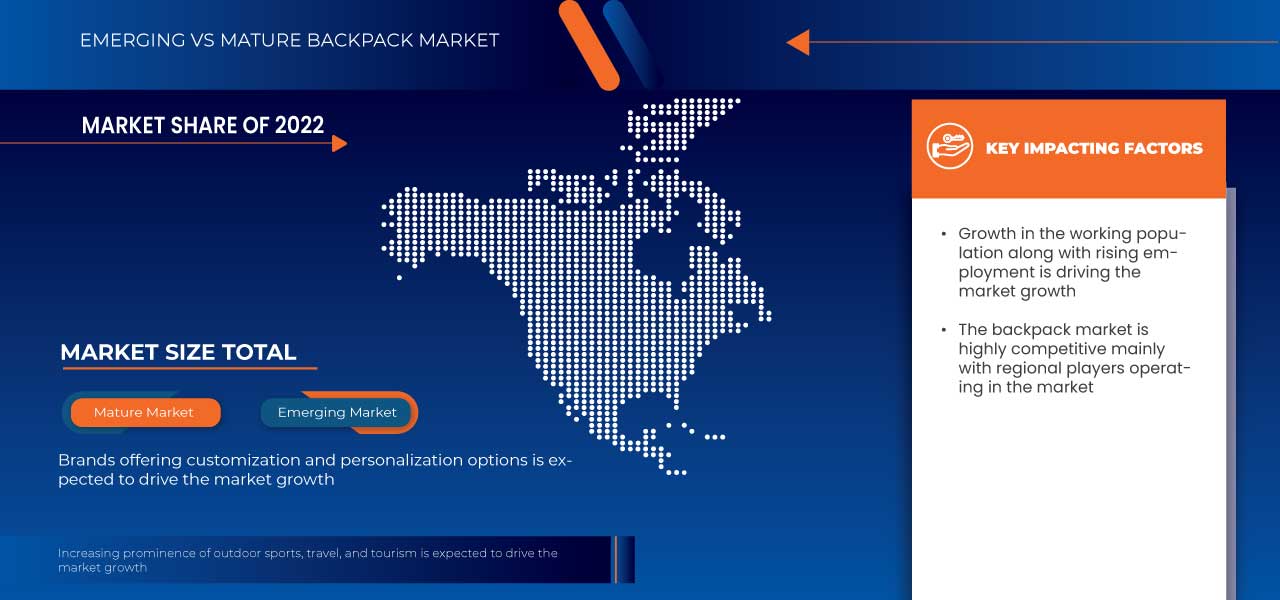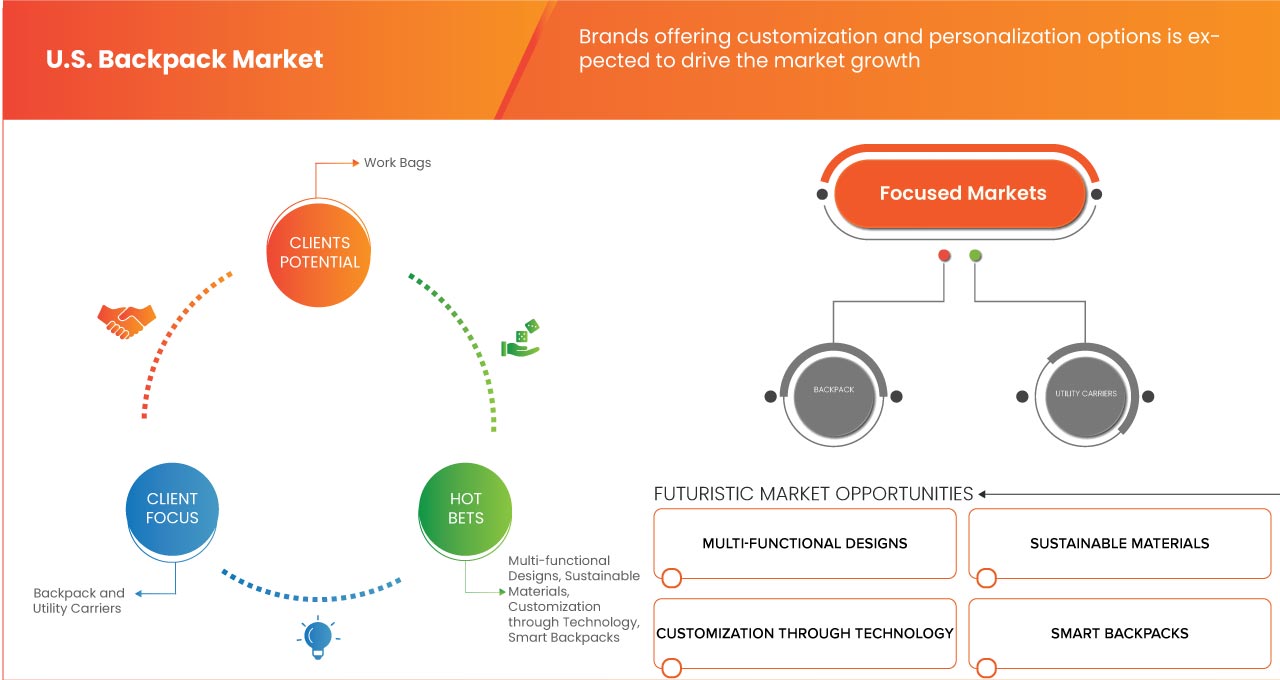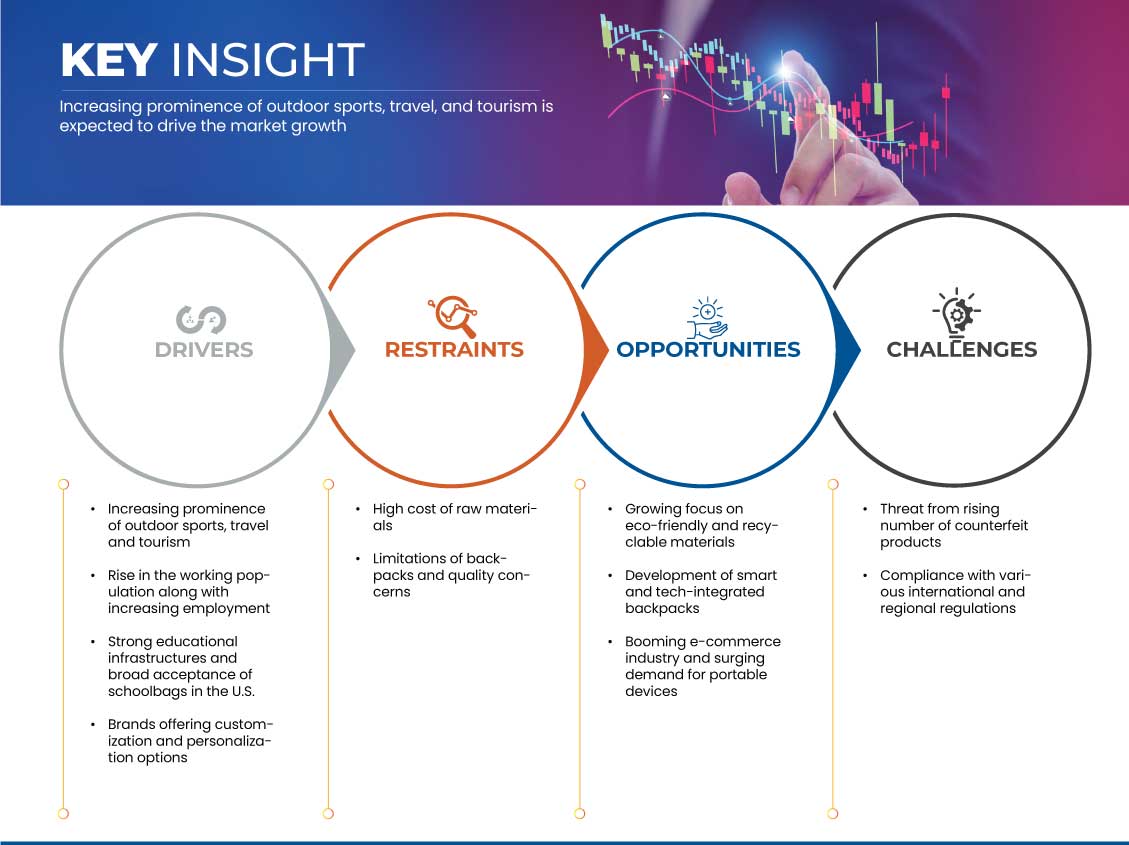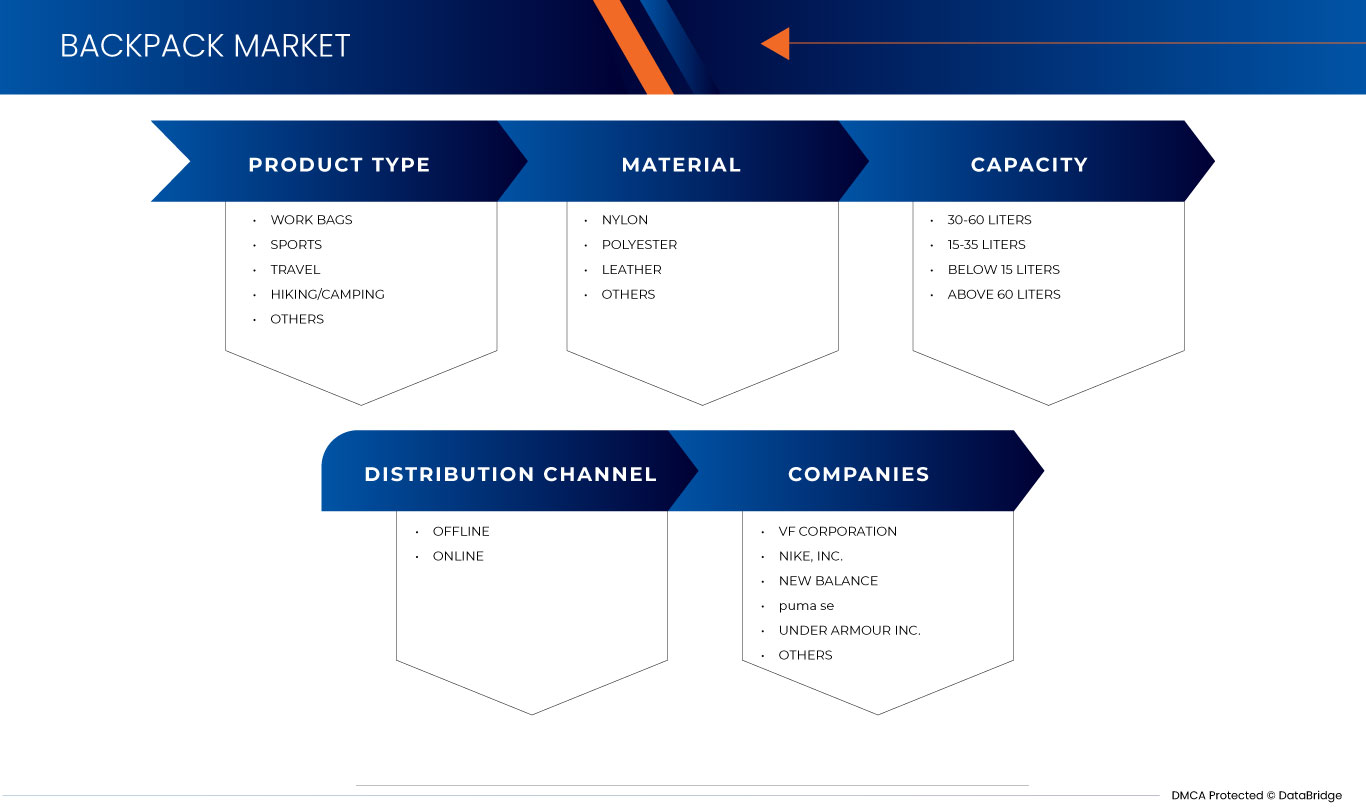Us Backpack Market
Tamaño del mercado en miles de millones de dólares
Tasa de crecimiento anual compuesta (CAGR) :
% 
| 2024 –2031 | |
| USD 5,132.22 Million | |
| USD 6,678.47 Million | |
|
|
|
U.S. Backpack Market, By Product Type (Work Bags, Sports, Travel, Hiking/Camping, and Others), Material (Nylon, Polyester, Leather, and Others), Capacity (30-60 Liters, 15-35 Liters, Below 15 Liters, and Above 60 Liters), Distribution Channel (Offline and Online) - Industry Trends and Forecast to 2031.
U.S. Backpack Market Analysis and Size
The growing significance of outdoor sports, travel, and tourism reflects an increased societal focus on recreational activities, exploration, and leisure, influencing consumer preferences and lifestyle choices, which is driving the market growth. Backpack limitations including ergonomic discomfort and functional constraints and quality concerns, including durability issues, potential wear and tear, negatively impact user satisfaction and brand reputation, which is restraining the market growth. The integration of features such as device charging, security enhancements, and health tracking caters to the evolving needs of consumers, which is expected to provide new opportunities for market growth. Regulatory compliance significantly impacts market players' operations and strategies, encompassing safety standards, environmental considerations, and trade agreements, which are expected to pose challenges to market growth.
Data Bridge Market Research analyzes that the U.S. backpack market is expected to reach USD 6,678.47 million by 2031 from USD 5,132.22 million in 2023, growing with a CAGR of 3.4% in the forecast period of 2024 to 2031.
|
Report Metric |
Details |
|
Forecast Period |
2024 to 2031 |
|
Base Year |
2023 |
|
Historic Years |
2022 (Customizable to 2016-2021) |
|
Quantitative Units |
Revenue in USD Million |
|
Segments Covered |
Product Type (Work Bags, Sports, Travel, Hiking/Camping, and Others), Material (Nylon, Polyester, Leather, and Others), Capacity (30-60 Liters, 15-35 Liters, Below 15 Liters, and Above 60 Liters), Distribution Channel (Offline and Online) |
|
Country Covered |
U.S. |
|
Market Players Covered |
VF Corporation, Nike, Inc., New Balance, PUMA SE, Under Armour Inc., Osprey, La Sportiva S.p.A., ASICS Corporation, Adidas AG, Lotto Spa, and HPG among others |
Market Definition
A backpack is lightweight, usually made of fabric bag that has shoulder straps so that it can be worn on the back and is used to carry personal items. It is a useful and popular attachment for hands-free carrying of objects such as books, laptops, clothes, and other necessities. Typically, backpacks have a primary compartment and extra pockets or sections for well-organized storage. In addition to having adjustable shoulder straps for comfort, many backpacks also have a handle that allows hand carrying when necessary. Backpacks are popular among hikers, tourists, and students. They are made in different sizes and styles to meet different demands. They offer a useful and practical way to carry items while equally spreading the weight across the shoulders of the wearer.
U.S. Backpack Market Dynamics
This section deals with understanding the market drivers, opportunities, challenges, and restraints. All of this is discussed in detail below:
Drivers
- Increasing Prominence of Outdoor Sports, Travel, and Tourism
Growing sporting culture and events are major drivers of the backpack market. Golf is becoming more popular as a recreational activity and a competitive sport as sporting culture spreads. This increase in golfers directly turns into a greater demand for sports gear and backpacks, which are necessary for transporting and protecting golf sticks and equipment. Furthermore, the increasing number of tournaments, from local to international championships, increases the need for high-quality bags to cater to professional golfers, amateurs, and spectators alike.
The increasing prominence of outdoor sports, travel, and tourism can significantly drive market growth by creating a surge in demand for versatile and durable backpacks that cater to the specific needs of enthusiasts engaging in these activities. The market for backpacks becomes integral to their functional and stylish gear as more individuals embrace a lifestyle centered on outdoor experiences. Thus, the increasing number of outdoor events and tournaments across the country is driving the market growth.
- Rise in the Working Population along with Increasing Employment
Rising occupation rates also influence consumer behavior, resulting in a desire to invest in high-quality, long-lasting backpacks that can survive the everyday wear and tear associated with commuting and professional activities. This shift in consumer preferences creates a growth factor in the market to deliver products that meet the durability and functionality expectations of the workforce. There is a greater desire for versatile and useful accessories that meet the needs of a busy, on-the-go lifestyle as more people enter the workforce. The growing working population and rising employment rates in the U.S. have the potential to be a significant drivers of the backpack industry.
Opportunities
- Growing Focus on Eco-Friendly and Recyclable Materials
The opportunities arising from this focus on sustainability extend to brand positioning and differentiation. Companies that proactively adopt eco-friendly practices can enhance their brand image, appealing to a broader customer base. The market rewards brands that demonstrate a commitment to sustainable and ethical practices, as consumers become more informed about the environmental impact of their purchases. This presents a competitive advantage for backpack manufacturers willing to invest in eco-friendly materials and transparent supply chains. In addition, regulatory trends and standards further drive the adoption of sustainable practices in the backpack market. Governments and international organizations are increasingly advocating for environmentally friendly manufacturing processes and materials. Manufacturers that align with these regulations not only contribute to global sustainability goals but also position themselves favorably in terms of compliance and corporate responsibility.
- Development of Smart and Technology Integrated Backpacks
The inclusion of smart features goes beyond charging capabilities. Tech-integrated backpacks often incorporate Bluetooth connectivity, enabling functionalities such as anti-theft alerts and GPS tracking. This not only enhances the security of belongings but also caters to the growing concern for personal safety. The integration of smart locks and fingerprint recognition adds an extra layer of security, making these backpacks appealing to a market increasingly valuing convenience and safety in daily life. Moreover, the development of smart backpacks extends into the realm of fitness and health tracking. Some backpacks come with integrated sensors that monitor physical activity, providing users with data on steps taken, calories burned, and even posture correction. This intersection of technology and health aligns with the prevailing wellness trends, contributing to the broader adoption of smart backpacks as lifestyle accessories.
Restraints/Challenges
- High Cost of Raw Materials
Manufacturers frequently try to absorb part of the increased costs, but if the price increases are significant, they may be obliged to pass these additional expenditures on to customers. This, in turn, can result in increased retail pricing for backpacks, thereby discouraging cost-conscious customers and impacting overall market demand. Common raw materials in backpack production include nylon, polyester, canvas for the outer shell, zippers, buckles for closures, foam for padding, and webbing, mesh for straps and ventilation. Furthermore, the competitive landscape of the backpack market is quite important. If a producer raises prices in response to rising raw material costs, it risks losing market share to competitors that maintain constant prices. This trend can pose issues for businesses seeking to reconcile cost demands with market position. Geopolitical events, trade policies, and supply chain disruptions are all examples of factors that influence raw material price variations. The continuous volatility in global markets may cause uncertainty for backpack makers, making it difficult to forecast and plan for consistent manufacturing costs.
- Threat from Rising Number of Counterfeit Products
Counterfeit backpacks, often imitating popular brands, have become prevalent in the market, fueled by the increasing demand for trendy and high-quality backpacks. This arrival of counterfeit products not only compromises the reputation of established brands but also poses serious risks for consumers. Moreover, consumers seeking affordable alternatives may unknowingly purchase counterfeit backpacks, believing them to be authentic. The inferior quality of these counterfeit products often leads to dissatisfaction, as they lack the durability and functionality expected from genuine backpacks. This mismatch between consumer expectations and the actual performance of counterfeit backpacks contributes to negative perceptions of the entire backpack market.
U.S. Backpack Market Scope
The U.S. backpack market is segmented into four notable segments based on product type, material, capacity, and distribution channel. The growth amongst these segments will help you analyze major growth segments in the industries and provide the users with a valuable market overview and market insights to make strategic decisions to identify core market applications.
Product Type
- Work Bags
- Sports
- Travel
- Hiking/Camping
- Others
On the basis of product type, the market is segmented into work bags, sports, travel, hiking/camping, and others.
Material
- Nylon
- Polyester
- Leather
- Others
On the basis of material, the market is segmented into nylon, polyester, leather, and others.
Capacity
- 30-60 Liters
- 15-35 Liters
- Below 15 Liters
- Above 60 Liters
On the basis of capacity, the market is segmented into 30-60 liters, 15-35 liters, below 15 liters, and above 60 liters.
Distribution Channel
- Online
- Offline
On the basis of distribution channel, the market is segmented into offline and online.
Competitive Landscape and U.S. Backpack Market Share Analysis
The U.S. backpack market competitive landscape provides details of competitors. Details included are company overview, company financials, revenue generated, market potential, investment in research and development, new market initiatives, production sites and facilities, company strengths and weaknesses, product launch, product trials pipelines, product approvals, patents, product width and breadth, application dominance, technology lifeline curve. The above data points provided are only related to the companies’ focus related to the market.
Some of the major market players operating in the U.S. backpack market are VF Corporation, Nike, Inc., New Balance, PUMA SE, Under Armour Inc., Osprey, La Sportiva S.p.A., ASICS Corporation, Adidas AG, Lotto Spa, HPG and among others.
SKU-
Obtenga acceso en línea al informe sobre la primera nube de inteligencia de mercado del mundo
- Panel de análisis de datos interactivo
- Panel de análisis de empresas para oportunidades con alto potencial de crecimiento
- Acceso de analista de investigación para personalización y consultas
- Análisis de la competencia con panel interactivo
- Últimas noticias, actualizaciones y análisis de tendencias
- Aproveche el poder del análisis de referencia para un seguimiento integral de la competencia
Tabla de contenido
1 INTRODUCTION
1.1 OBJECTIVES OF THE STUDY
1.2 MARKET DEFINITION
1.3 OVERVIEW OF THE U.S. BACKPACK MARKET
1.4 CURRENCY AND PRICING
1.5 LIMITATIONS
1.6 MARKETS COVERED
2 MARKET SEGMENTATION
2.1 MARKETS COVERED
2.2 YEARS CONSIDERED FOR THE STUDY
2.3 GEOGRAPHIC SCOPE
2.4 DBMR TRIPOD DATA VALIDATION MODEL
2.5 PRIMARY INTERVIEWS WITH KEY OPINION LEADERS
2.6 DBMR MARKET POSITION GRID
2.7 VENDOR SHARE ANALYSIS
2.8 MULTIVARIATE MODELLING
2.9 SECONDARY SOURCES
2.1 ASSUMPTIONS
3 EXECUTIVE SUMMARY
4 PREMIUM INSIGHTS
4.1 APPLICATIONS AND PRICE ANALYSIS: U.S. BACKPACK MARKET
4.1.1 APPLICATION AND PRICE ANALYSIS
4.1.2 VF CORPORATION
4.1.3 NIKE, INC.
4.1.4 NEW BALANCE
4.1.5 PUMA SE
4.1.6 UNDER ARMOUR INC.
5 MARKET OVERVIEW
5.1 DRIVERS
5.1.1 INCREASING PROMINENCE OF OUTDOOR SPORTS, TRAVEL, AND TOURISM
5.1.2 RISE IN THE WORKING POPULATION ALONG WITH INCREASING EMPLOYMENT
5.1.3 STRONG EDUCATIONAL INFRASTRUCTURES AND BROAD ACCEPTANCE OF SCHOOLBAGS IN THE U.S.
5.1.4 BRANDS OFFERING CUSTOMIZATION AND PERSONALIZATION OPTIONS
5.2 RESTRAINTS
5.2.1 HIGH COST OF RAW MATERIALS
5.2.2 LIMITATIONS OF BACKPACKS AND QUALITY CONCERNS
5.3 OPPORTUNITIES
5.3.1 GROWING FOCUS ON ECO-FRIENDLY AND RECYCLABLE MATERIALS
5.3.2 DEVELOPMENT OF SMART AND TECHNOLOGY-INTEGRATED BACKPACKS
5.3.3 BOOMING E-COMMERCE INDUSTRY AND SURGING DEMAND FOR PORTABLE DEVICES
5.4 CHALLENGES
5.4.1 THREAT FROM RISING NUMBER OF COUNTERFEIT PRODUCTS
5.4.2 COMPLIANCE WITH VARIOUS INTERNATIONAL AND REGIONAL REGULATIONS
6 U.S. BACKPACK MARKET, BY PRODUCT TYPE
6.1 OVERVIEW
6.2 WORK BAGS
6.3 SPORTS
6.4 TRAVEL
6.5 HIKING/CAMPING
6.6 OTHERS
7 U.S. BACKPACK MARKET, BY MATERIAL
7.1 OVERVIEW
7.2 NYLON
7.3 POLYESTER
7.4 LEATHER
7.5 OTHERS
8 U.S. BACKPACK MARKET, BY CAPACITY
8.1 OVERVIEW
8.2 30-60 LITERS
8.3 15-35 LITERS
8.4 BELOW 15 LITERS
8.5 ABOVE 60 LITERS
9 U.S. BACKPACK MARKET, BY DISTRIBUTION CHANNEL
9.1 OVERVIEW
9.2 OFFLINE
9.3 ONLINE
10 U.S. BACKPACK MARKET, COMPANY LANDSCAPE
10.1 COMPANY SHARE ANALYSIS: U.S.
11 SWOT ANALYSIS
12 COMPANY PROFILES
12.1 VF CORPORATION
12.1.1 COMPANY SNAPSHOT
12.1.2 REVENUE ANALYSIS
12.1.3 PRODUCT PORTFOLIO
12.1.4 RECENT DEVELOPMENTS
12.2 NIKE, INC.
12.2.1 COMPANY SNAPSHOT
12.2.2 REVENUE ANALYSIS
12.2.3 PRODUCT PORTFOLIO
12.2.4 RECENT DEVELOPMENTS
12.3 NEW BALANCE
12.3.1 COMPANY SNAPSHOT
12.3.2 PRODUCT PORTFOLIO
12.3.3 RECENT DEVELOPMENTS
12.4 PUMA SE
12.4.1 COMPANY SNAPSHOT
12.4.2 REVENUE ANALYSIS
12.4.3 PRODUCT PORTFOLIO
12.4.4 RECENT DEVELOPMENTS
12.5 UNDER ARMOUR INC.
12.5.1 COMPANY SNAPSHOT
12.5.2 REVENUE ANALYSIS
12.5.3 PRODUCT PORTFOLIO
12.5.4 RECENT DEVELOPMENTS
12.6 ADIDAS AG
12.6.1 COMPANY SNAPSHOT
12.6.2 REVENUE ANALYSIS
12.6.3 PRODUCT PORTFOLIO
12.6.4 RECENT DEVELOPMENTS
12.7 ASICS CORPORATION
12.7.1 COMPANY SNAPSHOT
12.7.2 REVENUE ANALYSIS
12.7.3 PRODUCT PORTFOLIO
12.7.4 RECENT DEVELOPMENTS
12.8 HPG
12.8.1 COMPANY SNAPSHOT
12.8.2 PRODUCT PORTFOLIO
12.8.3 RECENT DEVELOPMENTS
12.9 LA SPORTIVA S.P.A.
12.9.1 COMPANY SNAPSHOT
12.9.2 PRODUCT PORTFOLIO
12.9.3 RECENT DEVELOPMENTS
12.1 LOTTO SPA
12.10.1 COMPANY SNAPSHOT
12.10.2 PRODUCT PORTFOLIO
12.10.3 RECENT DEVELOPMENTS
12.11 OSPREY
12.11.1 COMPANY SNAPSHOT
12.11.2 PRODUCT PORTFOLIO
12.11.3 RECENT DEVELOPMENTS
13 QUESTIONNAIRE
14 RELATED REPORTS
Lista de figuras
FIGURE 1 U.S. BACKPACK MARKET: SEGMENTATION
FIGURE 2 U.S. BACKPACK MARKET: DATA TRIANGULATION
FIGURE 3 U.S. BACKPACK MARKET: DROC ANALYSIS
FIGURE 4 U.S. BACKPACK MARKET: COUNTRY VS REGIONAL MARKET ANALYSIS
FIGURE 5 U.S. BACKPACK MARKET: COMPANY RESEARCH ANALYSIS
FIGURE 6 U.S. BACKPACK MARKET: INTERVIEW DEMOGRAPHICS
FIGURE 7 U.S. BACKPACK MARKET: DBMR MARKET POSITION GRID
FIGURE 8 U.S. BACKPACK MARKET: VENDOR SHARE ANALYSIS
FIGURE 9 U.S. BACKPACK MARKET: SEGMENTATION
FIGURE 10 INCREASING PROMINENCE OF OUTDOOR SPORTS, TRAVEL, AND TOURISM IS DRIVING THE GROWTH OF THE U.S. BACKPACK MARKET IN THE FORECAST PERIOD OF 2024 TO 2031
FIGURE 11 THE WORK BAGS SEGMENT IS EXPECTED TO ACCOUNT FOR THE LARGEST SHARE OF THE U.S. BACKPACK MARKET IN 2024 TO 2031
FIGURE 12 DRIVERS, RESTRAINTS, OPPORTUNITIES, AND CHALLENGES OF THE U.S. BACKPACK MARKE
FIGURE 13 THE U.S. RETAIL SALES VIA E-COMMERCE IN 2022 (USD MILLION)
FIGURE 14 REVENUE EARNED BY COURIERS AND EXPRESS DELIVERY SERVICE IN THE U.S. (2018-2021) (USD MILLION)
FIGURE 15 U.S. BACKPACK MARKET: BY PRODUCT TYPE, 2023
FIGURE 16 U.S. BACKPACK MARKET: BY MATERIAL, 2023
FIGURE 17 U.S. BACKPACK MARKET: BY CAPACITY, 2023
FIGURE 18 U.S. BACKPACK MARKET: BY DISTRIBUTION CHANNEL, 2023
FIGURE 19 U.S. BACKPACK MARKET: COMPANY SHARE 2023 (%)
Metodología de investigación
La recopilación de datos y el análisis del año base se realizan utilizando módulos de recopilación de datos con muestras de gran tamaño. La etapa incluye la obtención de información de mercado o datos relacionados a través de varias fuentes y estrategias. Incluye el examen y la planificación de todos los datos adquiridos del pasado con antelación. Asimismo, abarca el examen de las inconsistencias de información observadas en diferentes fuentes de información. Los datos de mercado se analizan y estiman utilizando modelos estadísticos y coherentes de mercado. Además, el análisis de la participación de mercado y el análisis de tendencias clave son los principales factores de éxito en el informe de mercado. Para obtener más información, solicite una llamada de un analista o envíe su consulta.
La metodología de investigación clave utilizada por el equipo de investigación de DBMR es la triangulación de datos, que implica la extracción de datos, el análisis del impacto de las variables de datos en el mercado y la validación primaria (experto en la industria). Los modelos de datos incluyen cuadrícula de posicionamiento de proveedores, análisis de línea de tiempo de mercado, descripción general y guía del mercado, cuadrícula de posicionamiento de la empresa, análisis de patentes, análisis de precios, análisis de participación de mercado de la empresa, estándares de medición, análisis global versus regional y de participación de proveedores. Para obtener más información sobre la metodología de investigación, envíe una consulta para hablar con nuestros expertos de la industria.
Personalización disponible
Data Bridge Market Research es líder en investigación formativa avanzada. Nos enorgullecemos de brindar servicios a nuestros clientes existentes y nuevos con datos y análisis que coinciden y se adaptan a sus objetivos. El informe se puede personalizar para incluir análisis de tendencias de precios de marcas objetivo, comprensión del mercado de países adicionales (solicite la lista de países), datos de resultados de ensayos clínicos, revisión de literatura, análisis de mercado renovado y base de productos. El análisis de mercado de competidores objetivo se puede analizar desde análisis basados en tecnología hasta estrategias de cartera de mercado. Podemos agregar tantos competidores sobre los que necesite datos en el formato y estilo de datos que esté buscando. Nuestro equipo de analistas también puede proporcionarle datos en archivos de Excel sin procesar, tablas dinámicas (libro de datos) o puede ayudarlo a crear presentaciones a partir de los conjuntos de datos disponibles en el informe.









